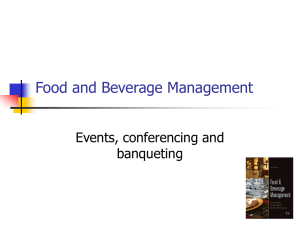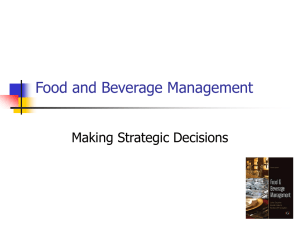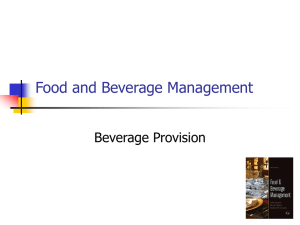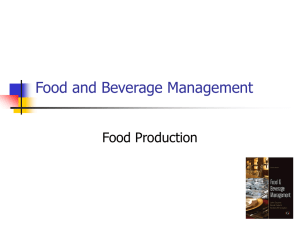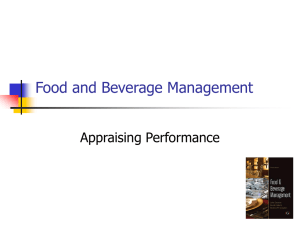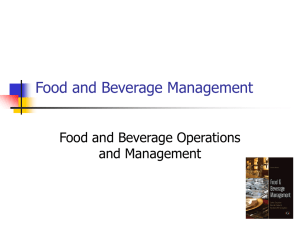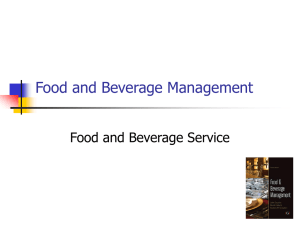Food and Beverage Managment 3rd Edition 2011
advertisement
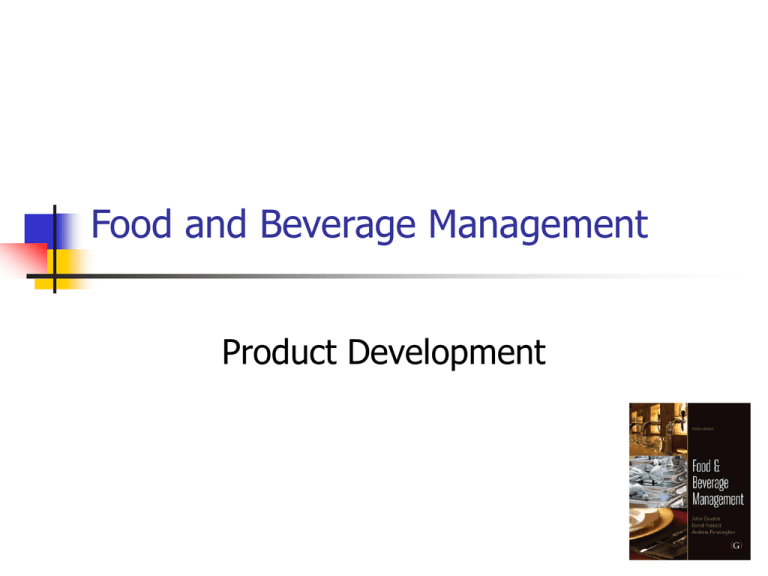
Food and Beverage Management Product Development The food and beverage product Is what operators construct and provide Marketers tend to identify the product as having tangible and augmented features Helpful to apply this framework to the development of concepts © 2011 Cousins et al: Food and Beverage Management, 3rd edition, Goodfellows Publishers The five meal experience factors 1. 2. 3. 4. 5. Food and beverages on offer Level of service Level of cleanliness and hygiene Perceived value for money and price Atmosphere of the establishment The importance of these factors to the customer changes depending on the needs they have at the time © 2011 Cousins et al: Food and Beverage Management, 3rd edition, Goodfellows Publishers Possible factor ranking for different meal experiences © 2011 Cousins et al: Food and Beverage Management, 3rd edition, Goodfellows Publishers Food and drink Provision must clearly focus on the needs and demands of the consumer The menu and beverage offerings are a list from which customers construct a package to suit their own needs Customer needs can be diverse Trying to satisfy everyone can lead to satisfying no one © 2011 Cousins et al: Food and Beverage Management, 3rd edition, Goodfellows Publishers Level of service Service is a part of the product and includes the human (usually) interface between the product and the consumer This interaction can deliver benefits to the customer and should therefore be designed into the product © 2011 Cousins et al: Food and Beverage Management, 3rd edition, Goodfellows Publishers Service framework Adapted from Martin 1986 © 2011 Cousins et al: Food and Beverage Management, 3rd edition, Goodfellows Publishers Cleanliness and hygiene Relevant to the premises, equipment and staff Increased media focus Customers more aware of the issues of cleanliness and hygiene Essential to ensure proper levels of cleanliness and hygiene at all times © 2011 Cousins et al: Food and Beverage Management, 3rd edition, Goodfellows Publishers Price and value for money Price relates to value, and is directly related to profitability Prices should be set to create a quality and value perception Need to establish the price range of potential customers Also need to establish the price range in which the operator can provide the products © 2011 Cousins et al: Food and Beverage Management, 3rd edition, Goodfellows Publishers Value a personal judgement Good value is where the worth is perceived as greater than the costs Poor value is where the costs are perceived as greater than the worth © 2011 Cousins et al: Food and Beverage Management, 3rd edition, Goodfellows Publishers Cost is not just the price Also includes: not being able to go somewhere else transport costs time having to look and behave certain way etc © 2011 Cousins et al: Food and Beverage Management, 3rd edition, Goodfellows Publishers Various pricing methods Cost plus Prime costing methods Backward pricing Rate of return Profit-per-customer Elasticity of demand Competition comparison © 2011 Cousins et al: Food and Beverage Management, 3rd edition, Goodfellows Publishers Atmosphere Created through the combination of factors such as: Design Décor Lighting Heating Furnishings Acoustics and noise levels Other customers The staff and the attitude of the staff © 2011 Cousins et al: Food and Beverage Management, 3rd edition, Goodfellows Publishers European Foundation for Quality Management Excellence Model Adapted from EFQM, 2010 © 2011 Cousins et al: Food and Beverage Management, 3rd edition, Goodfellows Publishers Customer service versus resource productivity © 2011 Cousins et al: Food and Beverage Management, 3rd edition, Goodfellows Publishers Providing customer service A combination of five characteristics: 1. 2. 3. 4. 5. Service level Service availability Level of standards Service reliability Service flexibility The ‘customer service specification’ must take these into account © 2011 Cousins et al: Food and Beverage Management, 3rd edition, Goodfellows Publishers Level of service:standards of service Level of service very limited to complex with high levels of personal attention Standards of service measure of how well the operation deliverers the service level it is offering © 2011 Cousins et al: Food and Beverage Management, 3rd edition, Goodfellows Publishers Level of customer service Written statements of both: Technical specification Service specification physical characteristics of the products procedures and the way they are carried out Often called the ‘customer service specification’ Need for balance between maintaining customer service and resource productivity © 2011 Cousins et al: Food and Beverage Management, 3rd edition, Goodfellows Publishers Integrated Service Quality Management Model © 2011 Cousins et al: Food and Beverage Management, 3rd edition, Goodfellows Publishers Consumer product relationship Final stages of development: Determine promotional channels Estimate profitability Plan product launch Offer product and appraise performance © 2011 Cousins et al: Food and Beverage Management, 3rd edition, Goodfellows Publishers Possible message and media © 2011 Cousins et al: Food and Beverage Management, 3rd edition, Goodfellows Publishers Web 2.0 applications Emerging trend User-generated content on website such as: Tripadvisor, Facebook and Twitter Also includes: blogs, social networks, metaverse, podcasts, wiki, tags and RSS © 2011 Cousins et al: Food and Beverage Management, 3rd edition, Goodfellows Publishers
